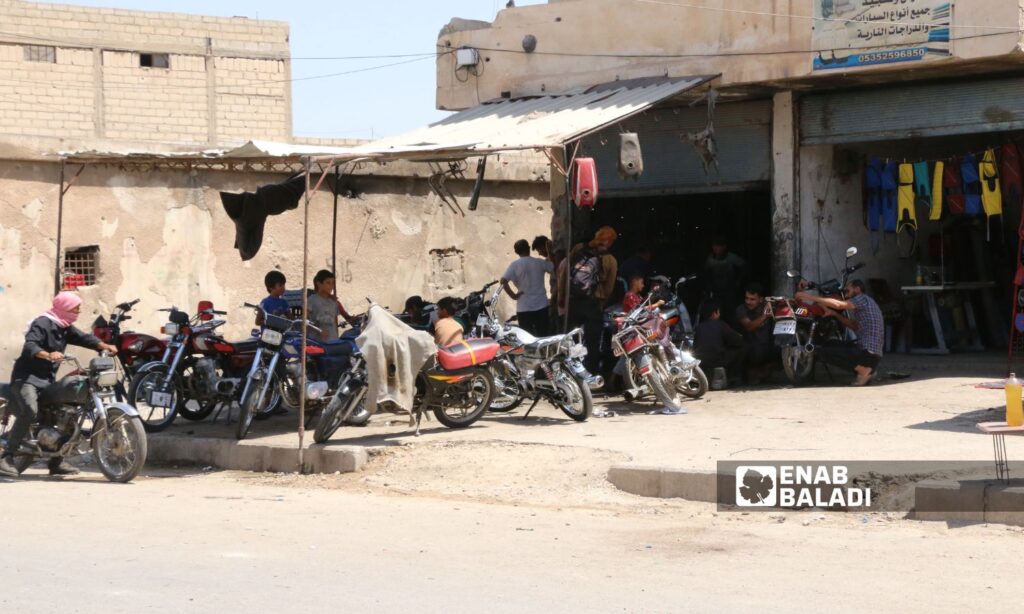Enab Baladi – Ras al-Ain
The motorcycle market in the city of Ras al-Ain in northwestern al-Hasakah is witnessing a drop in prices and low demand, accompanied by a shift towards repairing old motorcycles.
According to Enab Baladi‘s monitoring of motorcycle prices, the price of a “Gilang” model decreased from $900 to $700 (10.5 million Syrian pounds), and the “Bart” model from $575 to $430.
As for the modern types, such as “Honda Beat,” its price dropped from $650 to $525, and the price of used motorcycles without defects ranged between $300 and $350.
The currency circulating in Ras al-Ain is the Syrian pound, but motorcycle prices are set in dollars, with each US dollar equivalent to 15,000 Syrian pounds, according to the exchange rates and currency website “S-P Today.”
Weak purchasing power
The buying and selling of machinery and motorcycles in Ras al-Ain are linked to the agricultural season, as residents usually purchase what they need to meet their daily needs.
Due to the decline in profits from this year’s agricultural seasons and the financial losses experienced by farmers, the markets have witnessed overall stagnation and a slowdown, especially in the purchase of motorcycles, which more than 75% of the population rely on.
Raed Qahtan, from the village of Hamad, east of Ras al-Ain, told Enab Baladi that he used to change his motorcycle every year or at most every two years, as he relies on it primarily for traveling from his home to his farmland.
He added that the drop in wheat prices, which he cultivates and relies on for income, has pushed him to continue using his old motorcycle until conditions improve and he can afford a new one.
Qahtan’s situation is similar to that of young Ibrahim al-Ahmad from Haroubi village, west of Ras al-Ain, who used to buy a new motorcycle after the agricultural season because the old ones become worn out.
He told Enab Baladi that his losses in cumin and wheat seasons made him give up the idea of buying a new motorcycle and postpone it until the cotton season, adding that he would be repairing his old motorcycle.
Ineffective discounts
Qusai al-Karim, an owner of a motorcycle shop in Ras al-Ain, described the sales situation this year as stagnant compared to previous years.
He told Enab Baladi that most shop owners used to buy at least 50 motorcycles before the wheat and barley season to sell, but only a very small percentage of them were sold this year.
He added that he offered discounts that sometimes reached up to 40%, but demand remained very weak. Out of 40 motorcycles, he only sold eight, five of which were sold for cash and three on credit until the cotton season.
Active repairs
On the other hand, motorcycle repair shops have seen increased demand since repair costs are lower than buying a new motorcycle.
Oday al-Adwani, a motorcycle repair shop owner, said that the demand for repairs this year increased by up to 80%, which is unusual compared to the same time period every year.
He told Enab Baladi that he repairs more than 20 motorcycles daily, noting that most people request repairs on credit.
Ras al-Ain faces difficult economic and living conditions, and residents are affected by the earnings from the agricultural season, as agriculture and livestock farming are the main professions for most residents, forming a primary source of income.
Ras al-Ain and Tal Abyad lie near the Turkish border, controlled by the Turkish-backed Syrian National Army (SNA), while surrounded by battlefronts with the Syrian Democratic Forces (SDF). The Turkish border is considered the only outlet to the outside world.











